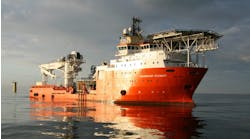Eric Deville
Yannick Callec
Guy Desaubliaux
Alain Mascle
Institut Français du Pétrole
Pascale Huyghe-Mugnier
University of Grenoble
Roger Griboulard
University of Bordeaux
Mark Noble
Paris School of Mines
The Orinoco turbidite system extends from the East Venezuela and Trinidad continental slope to the Atlantic abyssal plain. Most of the sediments of the Deep Orinoco delta and the Southern Barba-dos Ridge Complex originate from the South America continent and are sourced by the Orinoco River. Early multibeam and seismic acquisitions noticed locally that canyon incisions exit along the deep turbidite system where the channels cross-cut the frontal structures of the south of the Barbados accretionary prism.
Recent acquisitions with the French scientific O/V Atalante of multibeam data and backscattering imagery, seismic lines, and 3.5 kHz profiles provide coverage of the whole Orinoco turbidite system, except for the very upper continental slope. The data, coupled with new piston core samples, allows a better understanding of the past and recent depositional/erosional system and the structure of the area. This example of recent deepwater erosion processes can be used as a reference for the study of ancient and buried systems developed in an active tectonic context and in areas of shale or shale diapir activity.
null
Tectonic control
Because it is located in the east Cari-bbean or Lesser Antilles active margin, the Orinoco turbidite system is not a passive deep delta. The depositional system is morphologically and tectonically controlled by the compressional structures of the Barbados prism. One consequence is that the system does not exhibit classic fan geometry. The hinge between the slope of the front of the Barbados prism and the slope of the Guyana margin induces the convergence of the turbidite channels in the abyssal plain at the front of the accretionary prism. Upward, the system is multi-source with several distributaries. Downward, the channel courses are more complex, with frequent convergences or divergences that are emphasized by the effects of the undulating seafloor morphologies. The complex geometry of the seafloor of the southern Barbados area highlights the complex structures of the accretionary prism where tectonics, shale diapirism, and mud volcanism force the topography of the substratum, generating local highs and confined piggyback basins that control the channel courses.
Atypical channel system
Due to the active tectonic setting, related to the development of the southern Barbados accretionary prism, the recent Orinoco turbidite system presents an atypical evolution of channel architecture from the upper zone to the abyssal plain. In the upper zone, close to the Trinidad-Venezuelan continental slope, the seafloor is generally regular and is only locally disturbed by the intrusions of isolated mud-volcanoes.
Channel-levee complexes develop in the continental slope and in the piggyback basins above the accretionary prism.
Channels are characterized by well-developed aggrading channel-levees with highly sinuous and meandering geometries. Levee deposits are locally pinched out toward the intrusions. Downward, channel courses are controlled by the complex morphology of the substratum, and their geometries evolve systematically to canyons in the frontal zone. Active thrusting and related piggyback basin development drive channel courses. Tectonics, shale diapirism, and mud volcanism processes induce frequent and massive gravity deposits and control the morphology of the channels, from narrow channel-levees with locally confined levees in the piggyback basins to erosional channels and canyon geometries where they cut through the structures.
Ultra-deep sand-rich braided fan
In the upper abyssal plain, east of the front of the tectonic wedge, channels present a V shape with several terraces. Northward, in the abyssal plain, a large complex braided deep sea fan is developed with a main, low sinuous channel, which presents a tabular geometry with low aggrading channel-levee architecture. North-ward, a channel to lobes transition is observed with plane-convex elementary bodies, which are characteristic of sandy turbidite lobes. The main channel extends largely northeastward toward the Vidal Mid-Ocean Channel.
Piston-core academic surveys have demonstrated that turbidite sediments that transit the channels and canyon system and are deposited in the abyssal plain are mostly sand-rich. New piston coring operations where mostly coarse sandy deposits were found has confirmed this. These sand-rich deposits are also systematically covered by a few tens of centimeters of very recent pelagic planktonic-rich sedimentation, which shows that sand deposition has stopped since the last glacial event.
null
null
Deepwater erosion
A distinction of the Orinoco turbidite system is that no significant erosion is observed in the platform. Intensive oil and gas exploration in the offshore of Trinidad and in the Plataforma Deltana offshore east Venezuela confirm this. There is also no significant erosion along the present shelf break or in the upper slope. Whereas erosion processes are mostly absent in the upper part of the turbiditic system, they develop in the deepwater area between 2,000 and 4,000 m above the compressional structures of the Barbados prism as evidenced by multibeam data.
null
To define the geometry of the incisions, here are depth-migrated 3.5 kHz profiles. Data were pre-processed using the Seismic Unix package, then migrated in depth with a constant velocity model (1480 m.s-1). In the erosional area, ramp anticlines and abundant sedimentary mobilizations like shale diapirs and mud volcanoes control the channel courses by driving the turbidite flows. Incisions show irregular meandering and high sinuous courses in the low relieve segments and low sinuous courses where channels cut the structures. Where channels cut high morphologies, they are more confined without levee or asymmetric levee deposits and are deeply incised in the substratum with a characteristic U shape. Downward, channel courses are well controlled by the successive anticlines and evolve systematically to canyon geometries with a progressive increasing depth of incision.
In the thrust front zone, low sinuous meandering canyons cut the anticline ridges. Larger canyons show a maximum of 3 km wide for 300 m of deep incision. Mean dip in the flank of the incisions is steep, frequently higher than 15°. In the frontal folds of the accretionary prism, there is probably an antecedence of the channel course with respect to the final structure of the fold (syntectonic erosion). In front of the wedge, the main channel is characterized by sinuous anatomy and also presents canyon geometry with asymmetric levee deposits and a progressive transition to V shape of incision.
Depth-migrated 3.5 kHz profiles show different features of the erosion processes along the main deep canyon. In the upper part and in the abyssal plain, the incision occurred within channel-levee systems. In the front of the Barbados fold-and-thrust system, canyon erosion occurred deeply within ramp anticlines. The D section is a linear section through a low sinuosity meandering canyon. The canyon and the incised channel-levee system of the abyssal plain show the terrace geometry. The I section is in the sandy lobes north of the abyssal plain.
Polyphase incision processes
In the canyon area and just in front of the wedge, where the main channel also presents a canyon geometry, a progressive downward transition from U shape to V shape is observed, and several internal terraces appear in both flanks of the main channel. The occurrences of similar terraces in both flanks highlight the superposition of two mechanisms: the tectonic activity of the deformation front characterized by progressive uplift and thrusting of recent sediments, and the fluctuations of Orinoco turbidite system activity. Obviously, erosion occurred in different phases of successive incisions, leading to the development of the terraces. Probably, the successive erosion phases occurred during cyclic phases of lowstand of sea level during the strongest transit of the sand-rich turbidites toward the abyssal plain. During these lowstand events, there was a sedimentation bypass and a transit of sand-rich coarse-grained sandy sediments responsible for the erosion in the canyons.
Acknowledgment
Ifremer team onboard the O/V Atalante.








